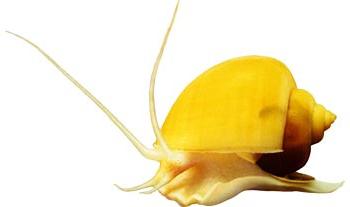Aquarium snails. Varieties
Aquarium snails play a huge role inmaintenance of biological balance in water bodies, therefore at least 2-3 mollusks should live in the aquarium. They perform the function of a filter, destroying algae and processing the remains of excess food. Moreover, most mollusks are pretty beautiful inhabitants and are able to properly decorate your watery area.
A large number of snails in one aquariumis undesirable because they eat up aquatic plants and consume oxygen, which is contained in water. Knowing the volume of the reservoir, you can easily calculate the number of snails required, based on the ratio: one snail per 10-12 liters of water. Aquarium snails are divided into ten species. The most common mollusks are: ampullaria, coil, melania, riverbird and pond snake.
Ampularia is a species of large snails inhabiting thefreshwater. The most popular habitat for these snails is South America and the zone of Asia. They are able to breathe oxygen, dissolved in water, and atmospheric oxygen, due to the fact that they have both lungs and gills. This structure of the respiratory system allows them for a long time to do without water. The eyes of the snails are located at the base of the antennae, the stems of which are very long. Also these aquarium snails have elongated breathing tubes. Ampularia is able to lay its eggs on the walls of the aquarium in the form of bunches that protrude from the water. Hatching young snails about 14 days after laying eggs. It should be remembered that the eggs are very vulnerable. They should be protected from the lamp so that they do not dry out. Feed young snails with small chopped plants like duckweed and riccia. Aquarium snails, the species of which are popular with aquarium lovers, is also a golden and giant ampularia.
The coil is found almost everywhere: in lakes, rivers and ponds. This type of snails can be easily distinguished by the particular type of shell, which is twisted in a single plane. The color of the shell may vary from brown or black to almost red. The diameter of the shell is 3 cm. The shell is very strong, which gives the snails a special vitality. Coils are adapted to exist in any water, no matter how dirty it is. They, like the ampullaria, are able to breathe both oxygen extracted from the water and atmospheric. These types of aquarium snails move at the expense of their feet, and are guided by a pair of tentacles. The unique ability of the coils is to move over the surface of the reservoir by attaching water tension to the surface film.
Milonia lives only on the territory of the tropicalAsia. Like many species of aquarium snails, milania grows to a length of up to three centimeters. The shell looks spirally twisted, conical. The color of the snail is gray-green with dark strokes. Breathes only the gills. Most of its existence, the snail spends in the ground, eating various organic remains, loosening the soil underneath. If the ground is damaged in the aquarium or the biological balance is disturbed, milanias tend to move to the walls, therefore, observing their behavior, it is possible to determine the state of water in the aquarium.
The proverb and riverbird are very commonin Europe and North America. These aquarium snails, the species of which can be found very often among aquarists, have a cone-shaped, rounded shape. The eyes are on the side of triangular tentacles. As these snails breathe air, from time to time they rise to the surface of the water. Prudoviks tend to eat quite a lot, so they can easily eat your underwater plants. Aquarium snails of this species are best kept in cool water, since in such an environment they are more active.
</ p>>







